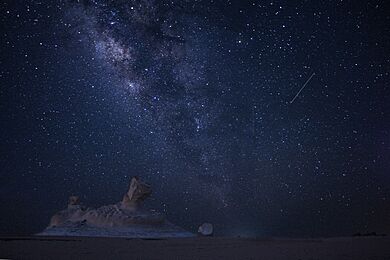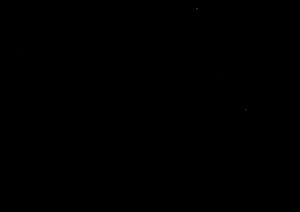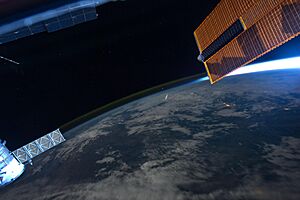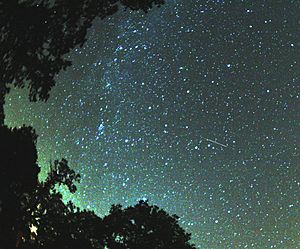Perseids facts for kids
Quick facts for kids Perseids (PER) |
|
|---|---|

Perseids in 2017 as seen from the White Desert, Egypt
|
|
| Pronunciation | /ˈpɜːrsi.ədz/ |
| Discovery date | AD 36 (first record) |
| Parent body | Comet Swift–Tuttle |
| Radiant | |
| Constellation | Perseus and Cassiopeia (near HD 19557) |
| Right ascension | 03h 13m |
| Declination | +58° |
| Properties | |
| Occurs during | July 14 – September 1 |
| Date of peak | August 12 (August 13 for 2023) |
| Velocity | 58.8 km/s |
| Zenithal hourly rate | 100 |
The Perseids are a prolific meteor shower associated with the comet Swift–Tuttle that are usually visible from mid-July to late-August. The meteors are called the Perseids because they appear from the general direction of the constellation Perseus and in more modern times have a radiant bordering on Cassiopeia and Camelopardalis.
Etymology
The name is derived from the word Perseidai (Greek: Περσείδαι), the sons of Perseus in Greek mythology.
Characteristics

(Variant of the animation in real time)
The stream of debris is called the Perseid cloud and stretches along the orbit of the comet Swift–Tuttle. The cloud consists of particles ejected by the comet as it travels on its 133-year orbit. Most of the particles have been part of the cloud for around a thousand years. However, there is also a relatively young filament of dust in the stream that was pulled off the comet in 1865, which can give an early mini-peak the day before the maximum shower. The dimensions of the cloud in the vicinity of the Earth are estimated to be approximately 0.1 astronomical units (AU) across and 0.8 AU along the Earth's orbit, spread out by annual interactions with the Earth's gravity.
The shower is visible from mid-July each year, with the peak in activity between 9 and 14 August, depending on the particular location of the stream. During the peak, the rate of meteors reaches 60 or more per hour. They can be seen all across the sky; however, because of the shower's radiant in the constellation of Perseus, the Perseids are primarily visible in the Northern Hemisphere. As with many meteor showers the visible rate is greatest in the pre-dawn hours, since more meteoroids are scooped up by the side of the Earth moving forward into the stream, corresponding to local times between midnight and noon, as can be seen in the accompanying diagram. While many meteors arrive between dawn and noon, they are usually not visible due to daylight. Some can also be seen before midnight, often grazing the Earth's atmosphere to produce long bright trails and sometimes fireballs. Most Perseids burn up in the atmosphere while at heights above 80 kilometres (50 mi).
Peak times
| Year | Perseids active between | Peak of shower |
|---|---|---|
| 2023 | July 14 – Sep 01 | August 13 08:00 UT (8% Waning Crescent Moon). Earth may have crossed the 69 BCE trail around August 14 02:00 UT. The New Moon is on Aug 16. |
| 2022 | July 17 – Aug 24 | August 12–13 (full moon on Aug 12) |
| 2020 | July 16 – August 23 | August 12–13 (ZHRmax 100) (full moon on Aug 3) |
| 2019 | July 17 – August 24 | August 12–13 (ZHRmax 80) (full moon on Aug 15) |
| 2018 | July 17 – August 24 | August 11–13 (ZHRmax 60) |
| 2017 | July 17 – August 24 | August 12 |
| 2016 | July 17 – August 24 | August 11–12 (ZHRmax 150) |
| 2015 | July 17 – August 24 | August 12–13 (ZHRmax 95) (new moon on Aug 14) |
| 2014 | July 17 – August 24 | August 13 (ZHRmax 68) (full moon on Aug 10) |
| 2013 | July 17 – August 24 | August 12 (ZHRmax 109) |
| 2012 | July 17 – August 24 | August 12 (ZHRmax 122) |
| 2011 | July 17 – August 24 | August 12 (ZHRmax 58) (full moon on Aug 13) |
| 2010 | July 23 – August 24 | August 12 (ZHRmax 142) |
| 2009 | July 14 – August 24 | August 13 (ZHRmax 173) (The estimated peak was 173, but a gibbous Moon washed out fainter meteors.) |
| 2008 | July 25 – August 24 | August 13 (ZHRmax 116) |
| 2007 | July 19 – August 25 | August 13 (ZHRmax 93) |
| 2006 | August 12/13 (ZHRmax 100) | |
| 2005 | August 12 (ZHR max 90) | |
| 2004 | August 12 (ZHRmax >200) | |
| 1994 | (ZHRmax >200) | |
| 1993 | (ZHRmax 200–500) | |
| 1992 | August 11 (outburst under a full moon on Aug 13) | |
| 1883 | August 9 or earlier | August 11 (ZHRmax 43) |
| 1864 | (ZHRmax >100) | |
| 1863 | (ZHRmax 109–215) | |
| 1861 | (ZHRmax 78–102) | |
| 1858 | (ZHRmax 37–88) | |
| 1839 | (ZHRmax 165) |
Historical observations and associations
Some Catholics refer to the Perseids as the "tears of Saint Lawrence", suspended in the sky but returning to Earth once a year on August 10, the canonical date of that saint's martyrdom in 258 AD. The saint is said to have been burned alive on a gridiron. His manner of death is almost certainly the origin of the Mediterranean folk legend claiming that the shooting stars are the sparks of Saint Lawrence's martyrdom. The legend holds that during the night of August 9 to 10, cooled embers appear in the ground under plants; these embers are known as the "coal of Saint Lawrence."
The transition in favor of the Catholic saint and his feast day on August 10 and away from pagan gods and their festivals, known as Christianization, was facilitated by the phonetic assonance of the Latin name Laurentius with Larentia.
In 1836 Adolphe Quetelet wrote: J'ai cru remarquer aussi une fréquence plus grande de ces météores au mois d'août (du 8 au 15) "I think I noticed also a greater frequency of these meteors in the month of August (from 8 to 15)." After studying historical records, he predicted a peak on 10 August. He then wrote to other astronomers, who confirmed this prediction on the night of 10 August 1837. Quetelet missed the shower due to bad weather.
In 1866, after the perihelion passage of Swift-Tuttle in 1862, the Italian astronomer Giovanni Virginio Schiaparelli discovered the link between meteor showers and comets. The finding is contained in an exchange of letters with Angelo Secchi.

See also
 In Spanish: Perseidas para niños
In Spanish: Perseidas para niños
- Leonids, associated with the comet Tempel–Tuttle
- Asteroid impact prediction
- Earth-grazing fireball
- List of asteroid close approaches to Earth
- Meteoroid




